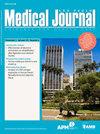库里蒂巴(巴西)某中风单位的质量指标
IF 1.6
4区 医学
Q2 MEDICINE, GENERAL & INTERNAL
引用次数: 0
摘要
在拉丁美洲,中风是导致死亡和残疾的第二大原因。因此,不断需要了解卒中患者的概况,以及分析卒中中心治疗的质量指标。目的:本研究的目的是分析某脑卒中中心的质量指标,确定住院患者的流行病学概况。方法:这是一项观察性横断面研究,纳入了2020年11月至2022年10月期间在Clínicas巴西联邦大学本文章由计算机程序翻译,如有差异,请以英文原文为准。
Quality indicators of a stroke unit in Curitiba (Brazil)
Introduction: Stroke represents the second leading cause of death and disability in Latin America. Thus, there is a constant need to understand the profile of patients admitted for stroke, as well as to analyze the quality indicators of treatment in stroke centers. Objectives: The aim of this study was to analyze the quality indicators of a stroke center and to determine the epidemiological profile of inpatients. Methods: This is an observational cross-sectional study that included individuals admitted with stroke or transient ischaemic attack (TIA) in the stroke unit of Complexo Hospital de Clínicas da Universidade Federal do Paraná from November 2020 to October 2022. The variables and quality indicators were collected through the application of questionnaires in two moments, on admission and hospital discharge. Results: Of the 407 patients included, 49.1% were men, with a mean age of 65.4 years (standard deviation ±15.3). Ischemic stroke was the most common type of stroke (84.5%). The majority of patients (62.6%) did not receive specific intervention, while 41.9% underwent intravenous thrombolysis, with a median door-to-needle time of 30 minutes. In 69.1% of the individuals, thrombolysis started in less than 60 minutes. All patients underwent neuroimaging, 90.9% carotid imaging and 92.6% had their cardiac rhythm rated by EKG or 24h-Holter. Dysphagia screening was applied in 62.4% of the cases and smoking cessation advice was provided in 50.5%. Of the patients with ischemic stroke and TIA, only 5 (1.3%) did not receive anticoagulant or antiplatelet agent for secondary prophylaxis and in 14 (3.75%) this data was unknown. Conclusion: Intravenous thrombolysis is not performed in most hospitalized patients, however, when performed, it presents an adequate door-to-needle time. Most patients received secondary prophylaxis. Management of patients in a stroke unit allows for a thorough etiological investigation and optimization of secondary prevention and rehabilitation.
求助全文
通过发布文献求助,成功后即可免费获取论文全文。
去求助
来源期刊

Sao Paulo Medical Journal
医学-医学:内科
CiteScore
2.20
自引率
7.10%
发文量
210
审稿时长
6-12 weeks
期刊介绍:
Published bimonthly by the Associação Paulista de Medicina, the journal accepts articles in the fields of clinical health science (internal medicine, gynecology and obstetrics, mental health, surgery, pediatrics and public health). Articles will be accepted in the form of original articles (clinical trials, cohort, case-control, prevalence, incidence, accuracy and cost-effectiveness studies and systematic reviews with or without meta-analysis), narrative reviews of the literature, case reports, short communications and letters to the editor. Papers with a commercial objective will not be accepted.
 求助内容:
求助内容: 应助结果提醒方式:
应助结果提醒方式:


